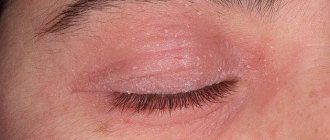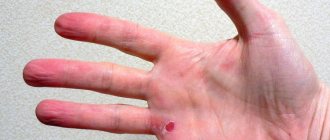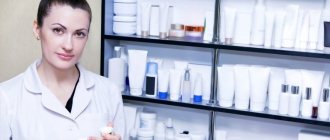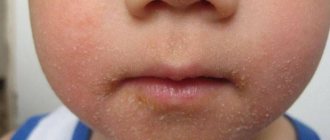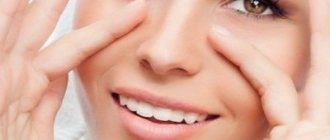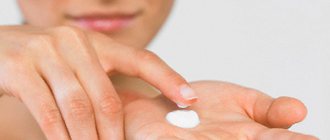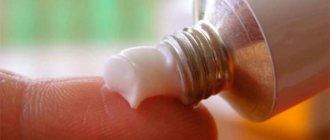Briefly about the reasons and factors
Depending on the cause that provoked the skin disease, experts divide it into classes. The primary factors that can provoke dermatitis include:
- physical factors , for example, exposure to negative temperatures or friction with things;
- biological factors , these include the juices of some plants and pollen;
- chemical factors. Among these, dermatitis often occurs due to the use of detergents or strong reagents.
Internal factors that cause dermatitis on the hands include:
- consumption of foods containing ingredients that cause food intolerance ;
- external allergens, such as chemicals. In addition, the problem develops while taking certain medications;
- allergies to cosmetics. For this reason, dermatitis on the hands often occurs among sales consultants in cosmetic departments;
- stressful situations and prolonged depression.
More often , the disease occurs against a background of reduced immunity . Chronic diseases are especially dangerous in this regard.
Antibacterial topical remedies for dermatitis
Antibacterial drugs are presented in several types:
- Levomekol. The drug is recommended by doctors due to its ability to fight swelling and inflammation. The product improves regeneration processes and renews tissue. Instantly heals wounds. It has side effects such as burning, redness, and swelling.
- Syntomycin ointment. Includes the active substance in the form of chloramphenicol, chloramphenicol. Offered for sale in doses of 1%, 5%, 10%. Used in case of suppuration of the skin, the addition of a bacterial process. Not for use by children, pregnant or lactating women.
- Tetracycline. The ointment has been tested against perioral dermatitis. Used as an auxiliary healing tactic. During therapy, it is necessary to refrain from using hand care compositions containing perfumery cosmetic fragrances.
- Gentamicin. The active ingredient of the composition is gentamicin sulfate, used strictly for external purposes. Indicated for treatment in case of progression of infectious and inflammatory processes. Prescribed on the recommendation of the treating specialist in strictly specified dosage regimens. Side effects include nausea, anemia, and kidney failure.
Combined ointments for dermatitis
There are combination remedies for dermatitis.
- Triderm. External cream containing 3 components (active). Fights inflammation and allergies. The hormone Betameson, the antibiotic gentamicin and the anti-fungal element clotrimazole are the composition of the drug. This allows it to be used in the treatment of infected focal lesions.
- Betazon ultra. The composition includes 3 active ingredients. The product is used for therapy for allergic dermatitis with complications. It reduces the degree of inflammation and leads to the neutralization of bacterial infections. It has a high threshold of activity, preferable when other similar compositions are ineffective.
- Triacutan. It is a combination of antibacterial, antipruritic, vasoconstrictor effect. Contains clotrimazole and gentamicin sulfate. It is used in the treatment of indolent dermatous lesions accompanied by the addition of a fungal infectious process.
Features of application
These drugs are usually used according to the classical scheme.
- Hands are cleaned with water and antibacterial soap.
- A medicinal composition is applied to them.
- Leave for a certain time, depending on individual instructions.
- It is washed off or absorbed into the skin.
Symptoms and signs of dermatitis on the hands
Acute dermatitis is accompanied by itching, burning and severe inflammation, expressed in the form of rashes and peeling of the skin. The following symptoms and signs of the disease can be identified:
- redness and swelling of the skin. At the site of the lesion, the skin appears reddish or bright pink. In addition, tissue swelling is detected, which can sometimes be significant.
In the event that dermatitis is caused by chemical exposure, the formation of bubbles filled with liquid contents is possible. Over time, the blisters burst and in their place peeling or ulcers form;
- thickening of tissues and changes in skin tone. When you touch the affected area, tissue compaction is noted, and the skin seems hot due to internal inflammation. In addition, over time, the purple tint of the skin turns into a pronounced cyanosis;
- the appearance of bubbles. Blister dermatitis at the initial stage looks like a regular callus. Subsequently, the callus bursts and plaques form. It is worth noting that, unlike ordinary calluses, dermatitis is not accompanied by painful symptoms when pressed;
- itching and burning. Symptoms characteristic of dermatitis, which are often accompanied by tissue swelling;
- limitation of the lesion. With dermatitis, the skin lesion has clear boundaries that indicate the impact of the irritant.
Usually, after eliminating the provoking factors, the disease passes quickly enough without leaving any traces.
Read more : ways to treat contact dermatitis at home.
Indications for use
Specialized topical anti-dermatitis formulations are used in the following cases:
- manifestation of a dermatitis condition of any form and degree;
- addition of a bacterial infection;
- formation of an inflammatory process;
- itching on the affected skin;
- redness of certain areas;
- excessive dryness of the skin;
- pain, burning, discomfort;
- worsening of the general condition caused by the disease;
- prevention of secondary complications.
Complex treatment
Treatment of dermatitis on the hands depends entirely on the form of the disease and the factors that provoked such a reaction in the body. The main recommendations during therapy are the following :
- avoiding contact with a possible irritant (in case of a contact form of the disease), using hand protection and nourishing creams to moisturize dry areas;
- use of hypoallergenic products for hand washing. You can purchase special skin care products for newborns;
- it is necessary to adjust the diet by excluding from the diet sweets and other foods that have an increased provoking factor for the development of allergies;
- It is important to strengthen the immune system and promptly treat chronic diseases.
If the disease does not go away for a long time, the dermatologist may prescribe complex therapy in the form of the following list of drugs:
- antihistamines. These include suprastin, cetrin and many others. Their effectiveness lies in blocking the mechanism of allergic reactions;
- natural sedatives such as motherwort and valerian. They allow you to eliminate dermatitis that occurs due to nervous tension;
- vitamin complexes . Strengthen the immune system and promote a faster process of skin regeneration;
- local drugs. They act directly on the affected area, relieve itching, burning and eliminate redness.
In addition to all of the above, in severe cases, patients are prescribed physiotherapeutic techniques, for example, darsonvalization.
Important! Treatment of non-contact dermatitis on the hands should be carried out comprehensively. First of all, specialists’ actions should be aimed at identifying the root cause of the disease.
Treatment of atopic dermatitis
A feature of the treatment of atopic dermatitis is a stepwise approach from simpler methods of external therapy and skin care to complex innovative techniques.
Remedies and methods for treating atopic dermatitis
When treating atopic dermatitis, the following are used:
- Softening and moisturizing creams and ointments are the basis for the treatment of atopic dermatitis. These products help keep your skin hydrated and soft.
- Steroid creams and ointments are applied to the skin and help relieve redness and itching. In severe cases, steroid tablets or injections may be required, but your doctor will keep the course of treatment as short as possible, since the high effectiveness of injections comes with a high risk of side effects.
- Medicines that affect the immune system are highly effective, but have side effects and may be prescribed when safer treatments do not produce the desired results.
- Antihistamines may be used in patients who report decreased itching.
- To increase the effectiveness of therapy, it is possible to perform wet wraps (Wet Dressing, Wet Wrap Therapy).
Wet wraps (Wet Dressing, Wet Wrap Therapy)
Treatment with Wet Wrap Therapy helps to quickly clear skin of rashes and can be used both in a medical facility or hospital, as well as at home. The effect is associated with improved penetration of the drug used, deeper and longer-lasting hydration, and reduced water loss by the skin. The dressings provide protection from scratching, which leads to the formation of an itch-scratch cycle, preventing scratches from occurring, which further intensify the itching, which makes the skin heal better. Cooling the surface of inflamed skin by evaporating water from the dressings helps reduce inflammation, itching and soreness.
For severe eczema, wet wraps are prescribed in a medical facility. They can also be used at home to maintain good health or at the first sign of deterioration and can reduce the need to seek medical help and the likelihood of hospitalization.
There are various modifications of Wet Wrap Therapy; the essence of the method is to use external medications (emollients or steroids) under two layers of bandages. The bottom layer is warm and moist, on top of which a second, dry layer is made. For the bandage, you can use a regular bandage, special tubular bandages, or special clothing. The bottom layer must be periodically moistened with ordinary warm water, preventing it from drying out. The use of topical steroids under a wet dressing can increase the effectiveness of treatment. The procedure can be performed 1-2 times a day, every day, during an exacerbation. As the exacerbation decreases, the procedure can be done less frequently, performed 1-2 times a week during the period of remission. If well tolerated, the bandage with the medicine can be left overnight, remembering to periodically moisten the bottom layer of tissue.
The procedure takes quite a long time, and in the first stages (especially in patients with severe skin damage) may require the participation of medical personnel. After training and improvement, the procedures can be continued at home.
Ointments and creams
Ointments and creams for dermatitis belong to the group of local medicines. Their use is extremely important, as it allows you to speed up the healing process several times and increase the effectiveness of general therapy. All drugs in this group are divided into the following types:
- non-hormonal agents;
- hormonal;
- drugs with complex effects.
Non-hormonal creams and ointments
Non-hormonal drugs are quite safe and can be used even in people with hypersensitivity. Many of them have a cumulative effect, which allows you to enhance the effectiveness of each new application. The most common non-hormonal drugs include:
- Eplan is a cream that relieves itching and burning sensation. It can be used for a variety of forms of dermatitis. In addition, it creates a special protective film on the skin, which allows it to be used as a prophylactic drug;
- Bepanten is a remedy for dry hand skin. The drug has a unique composition that allows you to increase the natural immunity of the skin and accelerate its regenerative abilities;
- Skin-Cap is a drug effective for atopic dermatitis. It is a safe product approved for use in children over 12 months of age. The ointment moisturizes the skin very well, eliminates itching and burning, and also prevents the development of inflammatory processes;
- Exoderil - despite the fact that the drug belongs to the group of antifungal agents, nevertheless, it can be used in the treatment of dermatitis in case of inflammation. The product destroys pathogenic microflora, accelerates the healing process of minor wounds and abrasions, for example, from scratching;
- Gistan is a cream of homeopathic origin. Its action is based on the healing properties of medicinal plants. Gistan moisturizes the skin, relieves itching and burning; in addition, it has a light texture and does not leave a greasy film on the surface of the hands;
- Randevit is a drug prescribed regardless of the form of the disease. The product is effective when there are minor abrasions and scratches on the skin. The active components of the product suppress pathogenic microflora, which helps prevent the risk of inflammation. In addition, regular use of Randevit increases the natural protection of the skin.
The list of the most suitable ointments can be continued for quite a long time. The most important thing to consider before purchasing is the individual characteristics of the patient’s body and the presence of allergic reactions to the active components of the product.
Hormone-containing drugs for dermatitis
Hormone-containing drugs are fairly effective drugs. Their effectiveness can be noticed after just a few uses.
Since hormonal ointments are potent drugs, their use should be fully agreed with the attending physician. In addition, you must carefully study the instructions and strictly follow them. Excessive use of hormonal drugs can cause complications.
Among the most well-known hormonal-based drugs are:
- Celestoderm - ointment is effective for a variety of forms of dermatitis, ranging from contact to allergic. The drug helps relieve itching, inflammation, redness, and also accelerate tissue regeneration in case of various injuries and scratches;
- Advantan - in addition to dermatitis, the ointment can be used for inflammation of various etymologies. Just like the previous drug, it helps relieve itching and burning, restore the integrity of the skin and speed up the healing process;
- Flucinar is a hormonal ointment used in the most advanced situations. In addition to the ointment, the drug is available in gel form. Due to the rather strong effect, the use of the drug should be strictly agreed with the attending physician;
- Flucicort is an ointment that dermatologists recommend that patients use when a bacterial infection is added to the main symptoms of dermatitis. The product suppresses pathogenic microflora, accelerates the process of tissue regeneration and eliminates other unpleasant consequences;
- Akriderm - used to treat all forms of dermatitis. It has a powerful effect and allows you to quickly get rid of the external manifestations of the disease.
Hormonal ointments are not recommended for use by pregnant and lactating women, as well as children. In rare cases, the drug may be prescribed to these groups of patients, and the possible benefit must be greater than the acceptable harm.
Combined ointments for dermatitis
Thanks to the combined composition, the action of such ointments is highly effective.
The use of these funds must also be agreed with a specialist.
The main combination ointments include:
- Fusiderm B - the drug contains the hormone betamethasone, which provides an antibacterial effect. At the same time, the ointment accelerates the healing process and prevents inflammatory processes. The product can be used for any form of dermatitis, including complicated ones. This drug is not recommended for use in children; as for pregnant and lactating women, in this case the benefit should outweigh the possible harm;
- Triderm is a combined action ointment used in case of complications of dermatitis. The product is used in children over 2 years of age. This is a relatively safe drug with a minimum of side effects;
- Fleming ointment is one of the safest drugs for dermatitis on the hands. The ointment is made on a homeopathic basis and has an antipruritic and wound-healing effect. In addition, the product can be used for inflammation of the skin area. Do not use during pregnancy or in case of individual intolerance.
It is important to understand that for effective treatment of dermatitis it is necessary to undergo a comprehensive examination , which will allow us to determine the root cause. Only in this case can a relapse be avoided. When treating dermatitis with ointments, remember the following rules:
- treatment should begin with the least potent drug, gradually moving to stronger drugs;
- all preparations are applied to dry skin;
- do not rub the ointment in, but wait until it is completely absorbed after application.
Classification of dermatitis
Facial dermatitis comes in different forms, so the characteristics of each type of disease differ from each other. Types of dermatitis localized on the face have their own characteristics of manifestation, so treatment is prescribed only by a specialist in each individual case. The factors that affect the body and provoke dermatitis of the scalp and face are also different.
Allergic dermatitis
The body's response to external irritants can result in dermatitis on the face. Usually in such cases, the provocateurs are chemical and cosmetic substances, medicinal compounds, animal hair, and synthetic fabrics. Symptoms of the allergic type have a set of common features:
- the face takes on a swollen appearance;
- swelling of the eyelids and tearing appear;
- headaches appear;
- the face is covered with reddish spots and a rash;
- itching and burning occurs in areas of skin damage;
- the normal functioning of the facial muscular system is disrupted.
In the allergic form of pathology, inflammation of the skin occurs on the face only in the presence of an irritant, so treatment should primarily be based on eliminating the allergen from the patient’s life.
Seborrheic dermatitis
Dermatitis on the face that occurs under the influence of pathogenic microflora caused by the proliferation of a group of lipophilic fungi is called seborrheic. The main signs of this form of the disease are severe peeling and hypertrophied dryness of the skin. Symptoms of seborrheic dermatitis on the face are always brightly colored:
- inflammation of the skin develops on the face into flaky epithelial layers that interfere with the normal functioning of cells;
- yellow or white keratinized layers cover the eyebrow area, nose, lips;
- itching becomes more intense;
- the skin is dehydrated and severely dry;
- against the background of dysfunction of the sebaceous glands, acne and purulent rashes occur.
Seborrheic dermatitis on the face and scalp has adverse symptoms and can affect the functioning of the hair follicles. Excessive loss of eyebrows and eyelashes can be observed in advanced forms.
Cosmetics for seborrheic dermatitis localized on the face should be completely removed from human life. The only exceptions are specialized ointments and creams used to treat the disease.
Rosacea-like dermatitis on the face, treatment
Rosacea-like dermatitis affects the face and parasitizes in the form of small pinkish acne, numerous purulent papules and redness. Under the influence of internal and external factors, the body’s immune response occurs: capillary vessels dilate, and the sebaceous glands begin to secrete increased secretion. Symptoms of the disease have common features:
- pathology occurs against the background of concomitant seborrheic dermatitis;
- the affected area is in the cheek area and nasolabial area of the face;
- the formation of pimples and acne is accompanied by roughening of the skin in areas of inflammation;
- vasodilation is visually reflected by a reddish mesh;
- The eyeballs and eyelids become inflamed, and tearing appears.
Rosacea-like dermatitis on the face requires long-term treatment as part of complex therapy. Treatment includes several stages, including preventive measures to prevent vasodilation of the facial skin:
- refusal of hot and spicy foods, as well as caffeine-containing products;
- eliminating bad habits;
- compliance with the normal work schedule of the day;
- work and live in comfortable climatic conditions;
- the use of ointments and creams with antibiotics;
- applications with herbal tinctures and Mitronidazole;
- laser therapy.
When diagnosing a disease, it is necessary to visit not only a dermatologist, but also a gynecologist, gastroenterologist, ophthalmologist, and endocrinologist . The manifestation of rosaceo can be a concomitant disease, with treatment of which the persistent rash also goes away.
Contact dermatitis
Contact dermatitis occurs on the face when the skin comes into direct contact with a provoking allergen. The most common provocateurs can be considered cosmetics for facial care and nickel jewelry. Contact type dermatitis on the face has symptoms similar to allergic manifestations. However, this type of pathology is characterized by three forms of manifestation:
- Irritant contact results in an immediate skin reaction, the appearance of severe burning and redness. Such reactions include sunburn or nettle burns, frostbite, and burns from potent chemicals.
- Allergic contact dermatitis occurs with the systematic use of cosmetic products and household chemicals.
- The photocontact form of dermatitis occurs when exposed to active sunlight. In such cases, it is best for patients to limit exposure to direct sunlight during active hours.
With contact dermatitis, pronounced symptoms persist: severe itching, burning, swollen face, peeling of the skin.
Atopic dermatitis
Facial dermatitis can be difficult to treat and become chronic. Most often, allergic dermatitis develops into atopic form or eczema, which is characterized by frequent periods of regression. Atopic dermatitis is localized on the face of adults around the lips, on the cheeks, on the eyelids, and in the forehead area. The symptoms of the pathology have the same manifestations in all patients:
- the face is covered with pronounced red spots;
- severe itching and peeling of inflamed areas;
- the affected areas become covered with crusts;
- wet areas appear;
- deep folds appear on the eyelids and in the area around the lips.
Most often, atopic dermatitis is a genetic disease, but disorders of the digestive system or metabolic disorders can also cause the disease. Allergic skin inflammation on the face most often leads to the development of atopy. Allergic dermatitis should be treated carefully, because when the allergy transforms into an atopic form, the disease very quickly becomes chronic.
Tick dermatitis on the face
Tick-borne dermatitis appears on the face as a result of tick bites that parasitize domestic and wild animals (rats, pigeons), in the grass, in fields with grain crops, in shoes. The disease is characterized by special manifestations:
- inflammation, visually similar to urticaria, covers the face with bright red spots;
- on each inflamed area there are red pinpoint hemorrhages, similar to a bite;
- the body's reaction to a tick bite occurs on the skin 12 hours after contact;
- spots become crusty;
- the number of spots depends on how many mites are simultaneously parasitizing on the face and their activity.
With this type of disease, very severe itching is observed, so it is necessary to take antihistamines. In addition, it is necessary to exclude any contact with the source of tick reproduction. The patient is also advised to take a hot shower to remove mites from the surface of the skin and the use of antiparasitic ointments.
Oral form of dermatitis
Perioral dermatitis affects the area around the mouth mainly in women. The face becomes covered with an unpleasant rash, which interferes with normal life activities. Symptoms of oral dermatitis include the following:
- red spots appear around the lips, going down to the chin, or up to the area near the nose;
- spots can change color saturation from pale red to bright red, depending on climatic conditions, nutrition, and medications.
The causes of oral dermatitis on the face include the following factors:
- use of hormonal therapy;
- use of cosmetics with strong fragrances or components that cause an allergic reaction;
- toothpaste containing fluoride-containing microelements;
- dysfunction of the digestive system;
- irrational food consumption during pregnancy.
When treating this form of the disease, hormonal ointments should not be applied to the face; they can provoke a sharp deterioration in the patient’s condition.
If you are interested in how to treat viral dermatitis in children, read our article.
Causes of atopic dermatitis, diagnosis and stages, photo in this article https://psoriazweb.ru/dermatity/kak-lechit-atopicheskij-dermatit-simptomy-i-prichiny-vozniknovenija.html.
The most effective ointments for allergic dermatitis in our material.
Folk remedies for the treatment of dermatitis on the hands
Folk remedies for the treatment of dermatitis on the hands are an excellent addition to complex therapy. In addition, some techniques are effective in themselves. Among the common recipes are the following:
- baths of chamomile and string infusion. Chamomile and string have a pronounced antibacterial and anti-inflammatory effect. To prepare a healing decoction, you need to take 2 tablespoons of dried plants and pour a glass of boiling water over them. After this, the mixture is heated in a water bath for 20 minutes. Then the broth is filtered and allowed to cool. Decoction-based baths are made 2-3 times a day. The duration of one procedure is at least 15-20 minutes. In addition, the decoction is used to prepare a compress;
- vegetable juice compresses . The juice of pumpkin, cucumber and potatoes helps effectively with dermatitis. For a compress, gauze bandages are soaked in juice and applied to the affected areas. Medical gloves are put on top to prevent the juice from spreading. The course consists of 10-15 days, 2-3 lotions daily;
- homemade honey ointment. To prepare the ointment, mix baby cream, honey and golden mustache juice. After this, the ingredients are thoroughly mixed and applied to the redness 2-3 times a day. The product is stored in the refrigerator in a tightly closed jar;
- lotions of fresh cranberry juice. For the recipe, mix cranberry juice and honey in equal proportions, and if desired, add a couple of drops of propolis infusion. After this, a gauze bandage is soaked in the product and applied to the skin with signs of dermatitis. The duration of the procedure must be at least 20 minutes;
- propolis oil. Apply this oil to the affected areas of the skin throughout the day. Healing lotions and compresses are also prepared on its basis. To prepare the oil, take 5-10 grams of natural propolis and pour in ½ cup of olive oil. After this, the mixture is heated in a water bath for an hour. You don’t have to strain the oil and use it immediately after the mixture has cooled. The product accelerates healing, relieves inflammation and destroys pathogenic microflora, which causes a purulent process.
In addition to the above, dermatologists recommend making compresses with vegetable juice at night . As a therapeutic technique, use sea buckthorn juice or seed oil.
Also follow these simple guidelines:
- Avoid contact with chemical irritants without additional protection in the form of gloves. These substances include washing powders and detergents;
- in autumn and winter, use thick cream and warm gloves to protect your skin;
- When the first symptoms of dermatitis appear on the hands, it is recommended to undergo a comprehensive examination. This will allow you to choose productive treatment if the disease is caused by immune disorders.
Useful video:
Symptoms and treatment of dermatitis:
Treatment of dermatitis on the hands should be comprehensive. Thanks to the right choice of medications, the problem can be dealt with in a relatively short time. In addition, dermatologists advise protecting the skin of your hands from adverse external influences.
If you find an error or traces of code (for example, individual characters >, ],=...), please select a piece of text and press Ctrl+Enter.
The use of non-hormonal ointments
The choice of one or another means is determined by the type of its action:
- antiseptic;
- anti-inflammatory;
- wound healing;
- moisturizing.
If we talk about the disadvantages of using these ointments for dermatitis on the hands, then it is worth saying that the effect of their use appears only after some time. However, some non-hormonal drugs cannot be used for more than 1 month. As a result, it turns out that the patient simply does not have time to completely get rid of the disease, and after some time the disease appears again.
In some cases, non-hormonal drugs may cause an additional allergic reaction. Therefore, before using the ointment, you should carefully read the instructions and contraindications.
Another disadvantage of these drugs is that they are powerless in treating the advanced stage of the disease. However, it all depends on the specific product.
